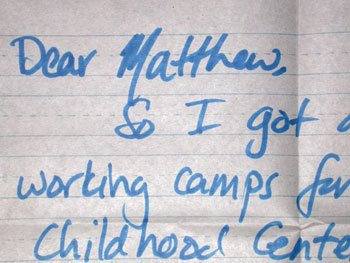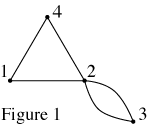July 30, 2005
Visiting the city of stone
Today i went to the Petra: Lost City of Stone exhibit at Calvin College. My primary motivation was to receive extra credit for my mythology class. To get the points, i actually have to write a paper on how the exhibit relates to this class. Nevertheless, i did find the presentation interesting.
There were a lot of people there which surprised me; i figured its been going on for a while and thought that all the people who were interested in such things would have seen it by now. Petra was a jumpin' join back in the day because it lied along some of major trade routes of the area. It assimilated characteristics of many of the surrounding areas, including Greece, Arabia, Egypt and the Roman Empire. The residents carved elaborate structures into the great stone cliffsof the landscape. It was the entrance to the great Khazneh tomb which was featured in the last Indiana Jones movie (though they made no mention of that fact in the exhibit).
The word petra is Latin for rock. It's this root that brings us the word petrified. Even though the artifacts were a bunch of old stones, there was enough information there to make them feel alive. I suppose that's worth the cost of admission.
July 27, 2005
One thing leads to another
It's amazing how one project turns into a whole series of new ones. It started with some data in an Access database that i needed to convert to a more usable form. I figured a well-written query should do the trick. It turned out that i was going to have to do a lot of data clean up and find ways to uncover the "extra" data buried within other values. I then decided to write a .NET app to do all the processing. Now i had a whole bunch of part numbers and descriptions that i had to classify into standard groups. With several thousand part numbers sitting in my new tables, i didn't want to have to do this by hand. I thought i might try some Bayesian filtering to automate the process. While typically associated with filtering spam, this technique can be used to classify as well. I've never written an app like does anything like that before so i thought i would look at what's already out there. There's a library called bow and an app called rainbow (how cute) that seemed interesting. Each is available as a set of files containing the C code necessary to compile it yourself. I'm still not that comfortable on my Mac command line, but now i've found myself trying to install fink and wondering how the heck i got here.
I really just need to stop now and get back to my homework.
July 24, 2005
Checking out the library
I went to the library this weekend to do some research for my mythology class paper. I believe the last time i actually wrote a research paper was in 9th grade so i'm a bit out of practice. I headed to the downtown branch because that's the only place i've ever thought of as a real library. I haven't been there a whole lot since the remodel so it took me a while to get my bearings. I found a few lucky dewy decimal numbers on the provided terminals and went on my hunt for knowledge. I found a few old, smelly books that could help me out but i doubted that i would have the time to actually them. Luckily, there were also a few booking in the "juvenile" section that covered the topic i had to research. That's right, i got most of my books for my research paper from the children's section. The books had a lot of useful information and pretty pictures and i didn't have to hunt to find the good stuff because there are only 30 pages or so.
I did take at least one serious looking book to put at the top of my stack as i headed for the checkout counter so as not to embarrass myself. It was at that point i realized that my library card was missing. I had to fill out a new little form and they issued me a new, plastic card and asked me to sign it. I used the provided BIC but it wasn't working. I swear they must dip those suckers in teflon. I could get out a stroke but then nothing else. I tried a different pen with the same results. I kept getting just a smear before the ink disappeared. I kept scribbling to get the thing to work. The end result is a signature that doesn't look a whole lot better than the one i remember being on my very first library card i got when i was in first grade.
July 22, 2005
Knowing what you don't know
I came across an article called Unskilled and Unaware of It and the theme of the article has been popping up around me ever since. The basic idea behind the article is that "...the skills that engender competence in a particular domain are often the very same skills necessary to evaluate competence in that domain-one's own or anyone else's." I've taken that to mean that if you think you're good at something, you probably aren't.
While the article shows how this is true in all disciplines, i've especially noticed this in the world of programming. If someone sounds too confident, it probably just means that they really have no idea of what can go wrong. I've been following along over at The Daily WTF which highlights horrible code that has been discovered in production software. Much of this code seems to come from "highly-paid consultants." These people claim to know a lot about programming, so such so that they feel justified in charging outrageous prices for their services, and yet the quality isn't there. The scary part is, they might not even realize it. In a book i'm reading there's a foreword from Joel Spolsky in which he says "...most software developers don't realize just how little they know about software development."
There comes a time when one must question his competence in the field he claims to be an expert in. It just may turn out that the more flaws one finds in his own work, the more proficient one is actually becoming. I suppose that's encouraging; though sometimes i wish i could trade in some of this "wisdom" for the oblivious enthusiasm of ignorance it seems to displace.
July 17, 2005
TechPubs debrief
Houston was very wet. As soon as i left the airport i was swimming in the soggy air. Now only was the weather hot and humid, but mother nature decided to throw some heavy rains our way. I saw on the local news that the showers caused all sorts of flooding over the city. Luckily, our travels weren't affected.
We had a full day of meetings on Thursday to discuss a new system to keep track of all the part numbers that go on a lift truck. This data includes labeled illustrations of major components and is used to create parts books. I learned a great deal about the manufacturing process. I also learned a whole bunch of new acronyms. It can be really hard to figure out exactly which parts are on a truck. MCFA makes a bunch of different models which can have a bunch of different variations and revisions in addition to changes resulting from engineering orders. Each truck can easily have around 5,000 part numbers. It's amazing they can track them at all.
During the question and answer part, it was a bit like attending a meeting of the United Nations. There were two gentlemen in from Japan; one of which felt comfortable communicating in English but the other one was the project manager who had all the answers. When someone from MCFA asked a question, the question had to be translated and that always took longer than i would have expected. Although i couldn't understand anything they were saying, I wouldn't be surprised that the Japanese words for "stupid americans" would sound familiar to me. While that was going on, the English speakers would go on with other conversations until finally we received the translated answer to the question we now barely remember. Thankfully the attendee from The Netherlands had no problems with English. Had there been another language involved that would have been tedious.
It was an interesting meeting. Perhaps the most valuable thing i learned, however, was that i should never voluntarily attend another Tech Pubs meeting again. It got a little boring after a while.
July 14, 2005
I'll be back y'all
I finally finished my silly English paper. Now i've gotta quick get some rest before i fly off to Houston. I'm going down for the company Worldwide Technical Publications Conference. I'm still not exactly sure what i'm getting my self into. I'll be back this weekend.
July 11, 2005
Dear Matthew
I truly enjoy writing letters, slapping a stamp on them, and sending them off in the mail. I also enjoy experimenting with different types of stationery. Luckily, I have like-minded friends. For example, today in my mail box i saw that my friend Lara had sent me a letter that had been written on the type of lined paper used in elementary schools when one first learns to print letters. It cracked me up. Perhaps i should ask for a few extra sheets to practice on that i might improve my notoriously poor penmanship.

If you plan to send me a letter too, you should know that the United States Post Office has decided to change my zip code. As of this month, i now live in the newly created 49534 zip code. It's going to take me a while to get used to that one in the same way that the first few checks i write in January are dated the previous year.
July 10, 2005
Microsoft wants to help with my wrting
I was poking around Amazon and stumbled upon a piece of software called Microsoft Student 2006. Apparently, it's supposed to help you get better grades. Here's part of the actual product description:
Tutorial content from leading publishers provide students with guidance on wrting (sic) reports, building presentations, or creating the right visuals on a project.
You would think that using a spell checker would be a good start. (view screenshot in case it's fixed.)
July 09, 2005
Doing homework at the movies
Thus far, my mythology class has involved reading a lot of ancient stories. We have also spent time talking about how modern day mythologies can still be found in the art of a culture. One such art form is modern cinema. Far more people watch movies than read books and from these films comes the fictional characters that everyone comes to know.
For our first class paper, we must describe how the plot of a movie relates to Joseph Campbell's archetypical hero's quest. We could choose between seeing Batman Begins or Star Wars: Revenge of the Sith. From the sounds of it, the whole class choose Batman. I saw it this morning. It was odd going to see a move at 10:00 AM. The theater was practically empty. It's odd when you only hear yourself laughing at the jokes. Luckily, i was able to find plenty of stuff to put my paper together.
There were a few plot points that i'm not sure i got quite right. If you saw the movie, can you answer any of these questions for me (and if you didn't see the movie, don't read them so i don't spoil anything)? When the kid first sees Batman and he says that the other kids are never going to believe him, what proof does Batman leave behind? It looked like some of his spy gear, but someone else thought it was one of those metal bats (but aren't those really sharp? would you give one to a kid?). Now, did Henri Ducard train the first Ras Al Guhl or did he just decide to pick up the master's work? Finally, the league of shadows had nothing to do with the death of Bruce's parents - in fact, it screwed with their plans, right?
July 04, 2005
Good Will Hunting's math
I recently re-watched Good Will Hunting with my friend Aubrey. She had done a scene from the movie in her acting class, but had never seen the film. With this viewing, i too got something new out of it. I was surprised to actually recognize the type of math problems Will solved on the hallway blackboard. That stuff was all graph theory which is part of what we covered in my discrete math class.

The first problem had a multigraph drawn on the board (see Figure 1). The question that accompanied the graph had four parts. The first two aren't that difficult. The first task is to construct an and adjacency matrix for the graph. To do that, all you have to do is determine which vertices (points) are adjacent to each other (directly connected by a line). The "matrix" part simply refers to how you present your results. You basically draw a table, and if vertex 1 and vertex 2 are directly connected, you put a "1" in row 1, column 2; if there's not, you put a "0" there. The finished matrix for this graph should look like Figure 2.

The second part of the problem involves creating another matrix, this time showing how many 3-step walks there are from each vertex to another vertex. A walk is simply a sequence of moves along the graph. For example, one 3-step walk from 1 to 2 would be to go from 1 to 2 (step 1), then up to 4 (step 2), then back to 2 (step 3). Also note that there are two ways to get from vertex 2 to vertex 3 and they each count as distinct walks. Assuming you get the same answer as Will and I did, your matrix would look like Figure 3.

The last part of the problem involved coming up with generating functions but we never got to those and they seem to involve a lot of linear algebra, which i haven't taken yet. Nevertheless, someone took the time to show how to solve the problem using Maple if you are interested.
Unfortunately, i cannot read the second problem that Dr Lambeau put on the board. However, i can tell you that Will's solution is a set of 8 trees, each of order 10. A tree is a special type of graph where it is impossible to leave one vertex and get back to that vertex without going over the same edge (line) more than once. If a graph has an order of 10, that simply means it contains 10 vertices, or points.
I remember when i first saw this movie, i had my doubts that some pictures of dots and lines would be the answer to an actual math problem. Now i'm happy to know that i almost understand it.
July 01, 2005
Do not wear after Aug 2008
I appreciate how shredded cheese comes in a re-sealable bag to help it stay fresh as long as possible. The same goes for tortillas and Chewy Chips Ahoy cookies. However, i was a bit surprised to find that t-shirts now come in a re-sealable bag. Seriously, what's the point of that? Should i be concerned with the freshness of my undergarments? Should i keep them in the bag until just before i want to put them on? I'm getting worried that there is a very important t-shirt lesson that i never learned.

On a barely related note, there has no been no other recent apparel innovation to make my body quite as happy as tagless t-shirts.